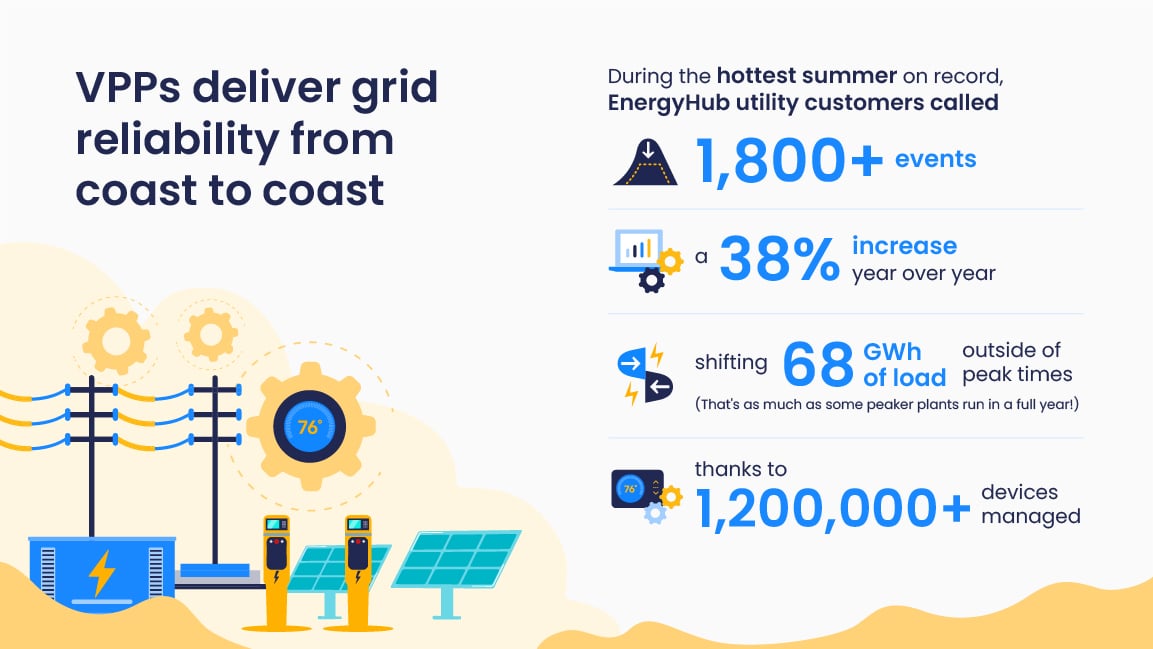
EnergyHub Team
November 2, 2023
EnergyHub clients called 1,800+ events – a 38% increase over 2022 – proving that VPPs can ensure grid reliability and keep customers safe and comfortable
(New York) November 2, 2023 – Record high temperatures this summer, with weeks of heat topping 100 degrees Fahrenheit, drove unprecedented electricity demand across North America. Despite extreme conditions, widespread use of virtual power plants (VPPs) helped keep the grid reliable and customers safe and comfortable.
EnergyHub clients called 1,831 events in 2023, shifting 68 GWh of energy usage out of peak times. That’s a 38% increase in resource utilization, accompanied by a 225% increase in load shift in thermostat programs. Further, that 68 GWh of load shift avoided 170 hours of natural gas peaker plant production, as much as some peakers run in a full year.
“VPP-based flexibility is essential to maintaining grid stability,” said Erika Diamond, SVP, Head of Customer Solutions at EnergyHub. “Utilities getting the most value from distributed energy resource (DER) programs rely on these resources more frequently, incorporating demand flexibility into grid operations in ways that go beyond emergency demand response.”
With more than 1,200,000 devices under management, EnergyHub’s flexibility programs are a core part of the utility resource stack, delivering distribution network support services in addition to mitigating system-wide effects of extreme heat.
Frequency and scale of flexibility events increase
In July, almost every bulk grid operator in North America called weather advisories that were escalated to conservative operations, capacity advisories, and even emergency alert conditions. EnergyHub works in nearly every Independent System Operator (ISO) footprint, and dispatched utility-owned and operated VPPs to maintain distribution system reliability while responding to pre-emergency or emergency alerts from ISOs.
Both the frequency with which utilities are deploying the resource and the scale of VPPs continue to grow. EnergyHub clients broke the company’s single-day event record on July 28th, dispatching VPPs 79 times over a 24-hour period. During that same period, utility customers continued to show high levels of customer participation despite the frequency with which events were called; two utilities in Arizona saw consistent average load shed in excess of 100 MW.
Northeastern utilities see benefits of VPPs beyond emergency demand response
Utilities in hot climates have used VPPs to great effect, especially during lengthy heat events. Notably, regions not typically prone to enduring heat events, such as New England, are using VPP-based flexibility to deliver benefits beyond emergency situations.
Northeast-based clients National Grid, Rhode Island Energy, Eversource, and Cape Light Compact have a VPP composed of 159,000 DERs and hundreds of C&I sites delivering 548 MW of flexible load via the EnergyHub platform.
By leveraging this sizable resource on dozens of potential peak load hours throughout the summer, these New England utilities and energy efficiency service providers are able to cost-effectively reduce the amount of capacity they’ll have to procure in the years to come. This puts significant downward pressure on wholesale prices that ultimately benefits ratepayers and the New England power sector as a whole.
Flexibility programs unlock new value streams for utilities nationwide
“Widespread adoption of DERs and higher customer engagement is not only relieving the stress associated with the frequency of emergencies across the bulk power system,” said Brady Klein, Director, Market Development at EnergyHub. “But utilities are also making flexibility a core part of their resource stack and using the resource to deliver a much wider array of value streams than they have in the past: daily dispatch to reduce monthly transmission peaks, calling for load relief based on proximity to constrained distribution system assets, or traditional peak shaving to reduce their capacity obligations down the road. Our clients are enabling a reliable grid, while simultaneously maximizing customer comfort and accelerating decarbonization of the power sector.”
In short: VPPs have become a critical tool helping utilities across North America deliver reliable, clean, and affordable power to customers against the backdrop of a changing climate and accelerating electrification.
EnergyHub is an independent subsidiary of Alarm.com (NASDAQ: ALRM), the leading platform for the intelligently connected property.
About EnergyHub
EnergyHub is the leading grid-edge DERMS provider. Utilities rely on EnergyHub’s DERMS platform to manage all distributed energy resources to serve grid and market objectives. EnergyHub works with over 60 utilities in North America to manage more than 1.7 GW of flexible capacity. We empower utilities and their customers to create a clean, distributed energy future. For more information, visit www.energyhub.com.
Interested in keeping up with the latest dispatch from the grid edge?
Get our next post in your inbox.


